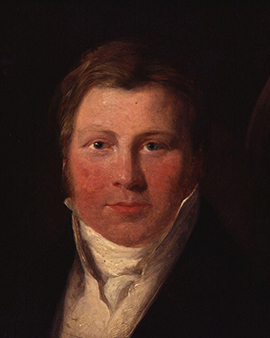


John Varley was a successful watercolour painter and author. He was born in London as the eldest of four children, who later all became artists as well. The children all came from the second marriage of his father, who moved from Yorkshire to London after the death of his first wife. Although Varley was interested in art as a child, his parents apparently did not believe that he could be successful. So they sent him to apprentice with a silversmith. Varley accepted his parents' decision as long as they lived. After their death, when he was about 15 years old, he was apprenticed for a short time to a local portrait painter. Shortly afterwards he attended Charles Barrow's evening drawing classes twice a week.
Barrow was a crucial figure in Varley's artistic development. They regularly went on field trips to make drawings on location. It was during one such excursion that Varley's first work was finally produced and accepted for the Royal Academy. His drawing of Peterborough Cathedral was exhibited at the Royal Academy in 1798. Varley was then a regular exhibitor at the Academy until he co-founded the Od Watercolour Society in 1805. After that he exhibited almost exclusively there. Thereby, he was a very active painter, as for the exhibitions of the Old Watercolour Society alone, he delivered far more than 700 paintings. Varley's claim to his watercolor paintings was that they could easily compete with oil paintings. Therefore he began to produce larger and more complex paintings from 1805. His best and most beautiful works date from this time. He found his preferred motifs in the wild landscape of North Wales, which he visited several times during his life. While he liked to draw directly from nature in his initial works, Varley began to paint landscape compositions from memory in his studio more and more frequently as he grew older.
Varley was not only very successful as a painter. He also published several treatises and manuals on painting and drawing. He was extremely popular as a teacher and, considering the success of his many students, he was also extremely talented. Among his students were David, Cox, Copley Fielding, John Linnell, William Henry Hunt and William Mulready, who married Varley's sister Elizabeth. Despite his great success Varley always had to struggle with money problems. This was partly because he had a very large family, and partly because he was not a very good businessman. Nevertheless, he did not seem to worry much and was described by his contemporaries as a hopeless optimist.

John Varley was a successful watercolour painter and author. He was born in London as the eldest of four children, who later all became artists as well. The children all came from the second marriage of his father, who moved from Yorkshire to London after the death of his first wife. Although Varley was interested in art as a child, his parents apparently did not believe that he could be successful. So they sent him to apprentice with a silversmith. Varley accepted his parents' decision as long as they lived. After their death, when he was about 15 years old, he was apprenticed for a short time to a local portrait painter. Shortly afterwards he attended Charles Barrow's evening drawing classes twice a week.
Barrow was a crucial figure in Varley's artistic development. They regularly went on field trips to make drawings on location. It was during one such excursion that Varley's first work was finally produced and accepted for the Royal Academy. His drawing of Peterborough Cathedral was exhibited at the Royal Academy in 1798. Varley was then a regular exhibitor at the Academy until he co-founded the Od Watercolour Society in 1805. After that he exhibited almost exclusively there. Thereby, he was a very active painter, as for the exhibitions of the Old Watercolour Society alone, he delivered far more than 700 paintings. Varley's claim to his watercolor paintings was that they could easily compete with oil paintings. Therefore he began to produce larger and more complex paintings from 1805. His best and most beautiful works date from this time. He found his preferred motifs in the wild landscape of North Wales, which he visited several times during his life. While he liked to draw directly from nature in his initial works, Varley began to paint landscape compositions from memory in his studio more and more frequently as he grew older.
Varley was not only very successful as a painter. He also published several treatises and manuals on painting and drawing. He was extremely popular as a teacher and, considering the success of his many students, he was also extremely talented. Among his students were David, Cox, Copley Fielding, John Linnell, William Henry Hunt and William Mulready, who married Varley's sister Elizabeth. Despite his great success Varley always had to struggle with money problems. This was partly because he had a very large family, and partly because he was not a very good businessman. Nevertheless, he did not seem to worry much and was described by his contemporaries as a hopeless optimist.
Page 1 / 2






